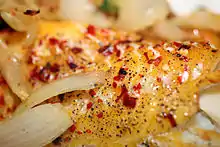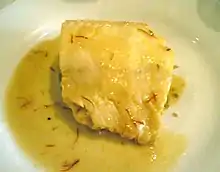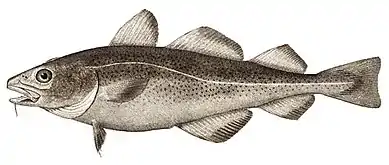Finnan haddie
Finnan haddie (also known as Finnan haddock, Finnan, Finny haddock or Findrum speldings) is cold-smoked haddock, representative of a regional method of smoking with green wood and peat in north-east Scotland.[1] Its origin is the subject of a debate, as some sources attribute the origin to the hamlet of Findon, Aberdeenshire, (also sometimes called Finnan) near Aberdeen,[2][3] while others insist that the name is a corruption of the village name of Findhorn at the mouth of the River Findhorn in Moray.[4] The "dispute" goes back to the eighteenth century, although it is hard to trace, as adherents fail to acknowledge even the possibility of the alternative view (except for the etymology note in the Oxford English Dictionary).[5] A testimonial in an early 20th century Boston cookbook describes the origin from a fire in a fish curing house in Portlethen, very near Findon. [6] It may have been a popular dish in Aberdeenshire since at least as early as the 1640s.[7]


Although known and admired in Scotland for a long time, Finnan haddie became a popular food item in London only in the 1830s. In earlier times, because of the light smoking that the fish received, it did not have a long shelf life—by most contemporary estimates, at most three days (although some suggested no more than one day).[1][2] Thus, although the fish was often available in Aberdeen "within twelve hours of being [caught]",[8] the distance to London was at that time nearly insurmountable if spoilage was to be avoided.[9] The fish started making its first appearances in London when shipped by established mail coach, but became widely available with the construction of the railway link connecting Aberdeen to London in the 1840s. The association with Findon became strong because of the Aberdeen connection. Occasionally, confusion was so deep that Findon was referred to as Findhorn.[10]
Finnan has a long association with the traditional Scottish fish soup, Cullen skink and most old Scottish recipe books cite Finnan haddie as the smoked haddock to be used for this dish.
The traditional preparation is to roast or grill the whole pieces of fish over high heat.[1] Finnan haddie is also often served poached in milk for breakfast[11] and is an important part of traditional kedgeree and the Arnold Bennett omelette.[12]
In popular culture
Finnan haddie is used as a sexual double entendre in the Cole Porter song "My Heart Belongs to Daddy", and is mentioned in the Lew Pollack/Sidney D. Mitchell song "At the Codfish Ball", as well as in Otto Preminger's 1953 comedy, "The Moon Is Blue". It was also humorously referenced in the title of the 1942 Warner Brothers cartoon Fin'n Catty, directed by Chuck Jones, as well as the Paramount movie "Finn and Hattie" (1931). It's mentioned in the song "My Heart Belongs to Daddy" sung by various artists, including Marilyn Monroe and Julie London. It is mentioned in the comic book Iron Man #164 (Nov 1982). "Steamed Finnan Haddie" is mentioned in the opening scenes of the 1954 movie "Executive Suite".
References
- McCulloch, John Ramsay (1843). McCulloch's Universal Gazetteer: A Dictionary, Geographical, Statistical and Historical of the Various Countries, Places and Principal Natural Objects in the World. Volume 1. New York: Harper Brothers. p. 909.
- "Before bringing this introductory letter to a close, I shall remind the Stranger of the opportunity which he now so happily enjoys, of eating, in all their perfection, the far-famed Finnan Haddocks. These, he may be informed, are prepared at a small fishing village called Finnan, or Findon, about six miles to the south; and, like Rowland's 'Incomparable Oil Macassar,' have been the subject of innumerable imitations, 'of the most deleterious tendency.'"The Book of Bon-accord: or, A Guide to the City of Aberdeen. Aberdeen: Lewis Smith. 1839. p. 17.
- Adam and Charles Black (1845). "Fifteenth Tour". Black's Picturesque Tourist of Scotland (4th ed.). Edinburgh: Adam and Charles Black. p. 380.
- "Late as the hour was (and it was long past midnight), the whole family were still on foot, and far from proposing to go to bed; the dame was still busy broiling car-cakes on the girdle, and the elder girl, the half-naked mermaid elsewhere commemorated, was preparing a pile of Findhorn haddocks (that is, haddocks smoked with green wood), to be eaten along with these relishing provisions."Scott, Sir Walter (1816). Antiquary.
- "A place-name used attrib. apparently originally the name of the river Findhorn, or of a place so called on its banks; but confused with Findon, the name of a village in Kincardineshire".""finnan, n." December 2011". OED Online. Oxford University Press. Retrieved 21 January 2012.
- "Many years ago at a seaport town on the North Sea, Port Lethen, a fire occurred in one of the fish-curing houses, and partially burned the end of a structure which was piled full of lightly salted, freshly caught haddock, which were lying on beds of dry kelp." Griffin, J. H. Recipes for Sea Food. Boston: Freeman & Cobb Co., 1913. https://archive.org/stream/recipesforseafoo00free#page/n175/mode/2up
- Perhaps the first reference to Finnan haddie, being served for breakfast at a country pub in 1643
- "Dunnotar Castle (footnote)". Mirror of Literature, Amusement and Instruction. 23 (657): 249. 12 April 1834. Retrieved 21 January 2012.
- The Topographical, Statistical, and Historical Gazetteer of Scotland. Volume First: A–H. Glasgow: A. Fullarton & Co. 1842. pp. 553–554.
- "The Fish-people of Aberdeen". The Penny Magazine. 9 (544): 369–370. 26 September 1840. Retrieved 21 January 2012.
- For many families, milk poached finnan haddie is a traditional Christmas breakfast, served with fried scones. In many areas of America finnan haddie is only available in grocery stores in the week or two before Christmas. Full recipe for Finnan Haddie from Scottish chef John Quigley Archived 2007-10-24 at the Wayback Machine
- Dahl, Sophie. "Arnold Bennett Omelette". BBC Food Recipes. BBC. Retrieved 21 January 2012.

